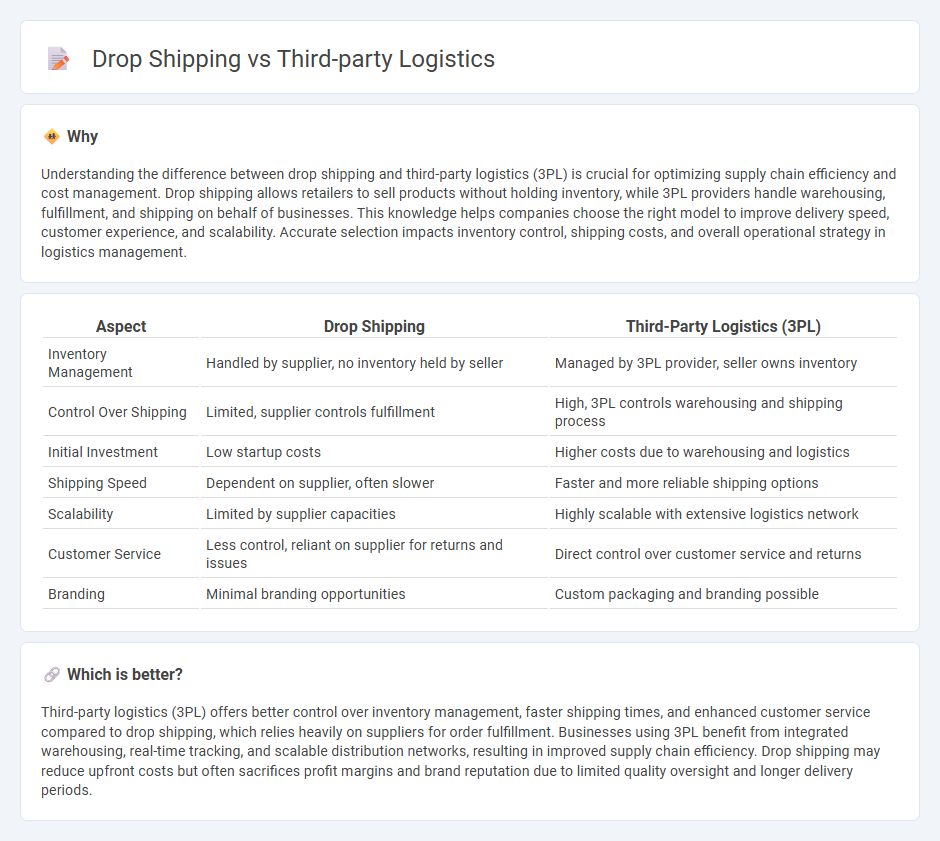
Dropshipping allows retailers to sell products without holding inventory by directly forwarding customer orders to suppliers who ship items on their behalf, minimizing upfront investment and storage costs. Third-party logistics (3PL) providers offer comprehensive supply chain services including warehousing, order fulfillment, and transportation, enabling businesses to scale operations and improve delivery efficiency. Explore the benefits and challenges of dropshipping versus 3PL to determine the best logistics strategy for your business.
Why it is important
Understanding the difference between drop shipping and third-party logistics (3PL) is crucial for optimizing supply chain efficiency and cost management. Drop shipping allows retailers to sell products without holding inventory, while 3PL providers handle warehousing, fulfillment, and shipping on behalf of businesses. This knowledge helps companies choose the right model to improve delivery speed, customer experience, and scalability. Accurate selection impacts inventory control, shipping costs, and overall operational strategy in logistics management.
Comparison Table
| Aspect | Drop Shipping | Third-Party Logistics (3PL) |
|---|---|---|
| Inventory Management | Handled by supplier, no inventory held by seller | Managed by 3PL provider, seller owns inventory |
| Control Over Shipping | Limited, supplier controls fulfillment | High, 3PL controls warehousing and shipping process |
| Initial Investment | Low startup costs | Higher costs due to warehousing and logistics |
| Shipping Speed | Dependent on supplier, often slower | Faster and more reliable shipping options |
| Scalability | Limited by supplier capacities | Highly scalable with extensive logistics network |
| Customer Service | Less control, reliant on supplier for returns and issues | Direct control over customer service and returns |
| Branding | Minimal branding opportunities | Custom packaging and branding possible |
Which is better?
Third-party logistics (3PL) offers better control over inventory management, faster shipping times, and enhanced customer service compared to drop shipping, which relies heavily on suppliers for order fulfillment. Businesses using 3PL benefit from integrated warehousing, real-time tracking, and scalable distribution networks, resulting in improved supply chain efficiency. Drop shipping may reduce upfront costs but often sacrifices profit margins and brand reputation due to limited quality oversight and longer delivery periods.
Connection
Drop shipping relies on third-party logistics (3PL) providers to manage inventory storage, order fulfillment, and shipping processes, enabling sellers to operate without holding stock. These 3PL companies optimize supply chain efficiency by handling warehousing, packaging, and last-mile delivery, reducing operational costs for drop shippers. The integration of drop shipping with third-party logistics services streamlines product distribution and enhances scalability for e-commerce businesses.
Key Terms
Inventory Management
Third-party logistics (3PL) providers manage inventory storage, handling, and distribution, offering businesses greater control over stock levels and order fulfillment accuracy. Drop shipping eliminates the need for inventory holding by directly shipping products from suppliers to customers, reducing overhead but limiting inventory control. Explore the differences in inventory management strategies to determine which model best fits your business needs.
Order Fulfillment
Third-party logistics (3PL) companies specialize in comprehensive order fulfillment by managing warehousing, inventory, and shipping on behalf of retailers, ensuring efficient and timely delivery. Drop shipping eliminates the need for stock holding by transferring customer orders directly to suppliers who ship products individually, reducing overhead but potentially increasing delivery times. Explore deeper insights into how order fulfillment shapes e-commerce strategies by comparing these two approaches.
Supplier Integration
Third-party logistics (3PL) involves a seamless integration between suppliers and logistics providers to manage inventory, warehousing, and fulfillment, ensuring efficient supply chain coordination. Drop shipping relies on direct supplier-to-customer shipping without holding inventory, requiring strong communication channels but less operational integration. Explore the differences in supplier integration strategies to optimize your e-commerce fulfillment model.
Source and External Links
What is a 3PL? Third-Party Logistics Process Explained - A 3PL is a company providing logistics services like warehousing, kitting, and shipping, managing inventory and order fulfillment to help businesses optimize supply chain operations and reduce costs through volume discounts and efficient shipping consolidation.
What is 3PL (third-party logistics)? - A 3PL provider offers outsourced logistics services such as storage, shipping, and transportation management, allowing businesses to focus on core competencies while controlling shipping costs by contracting supply and distribution when needed.
Understanding 3PL: Benefits and Purpose of Third-Party ... - Partnering with a 3PL provider allows businesses to outsource logistics functions like transportation and warehousing, benefiting from flexibility, scalability, advanced technology, and cost reduction, which enhances overall logistics efficiency.
 dowidth.com
dowidth.com